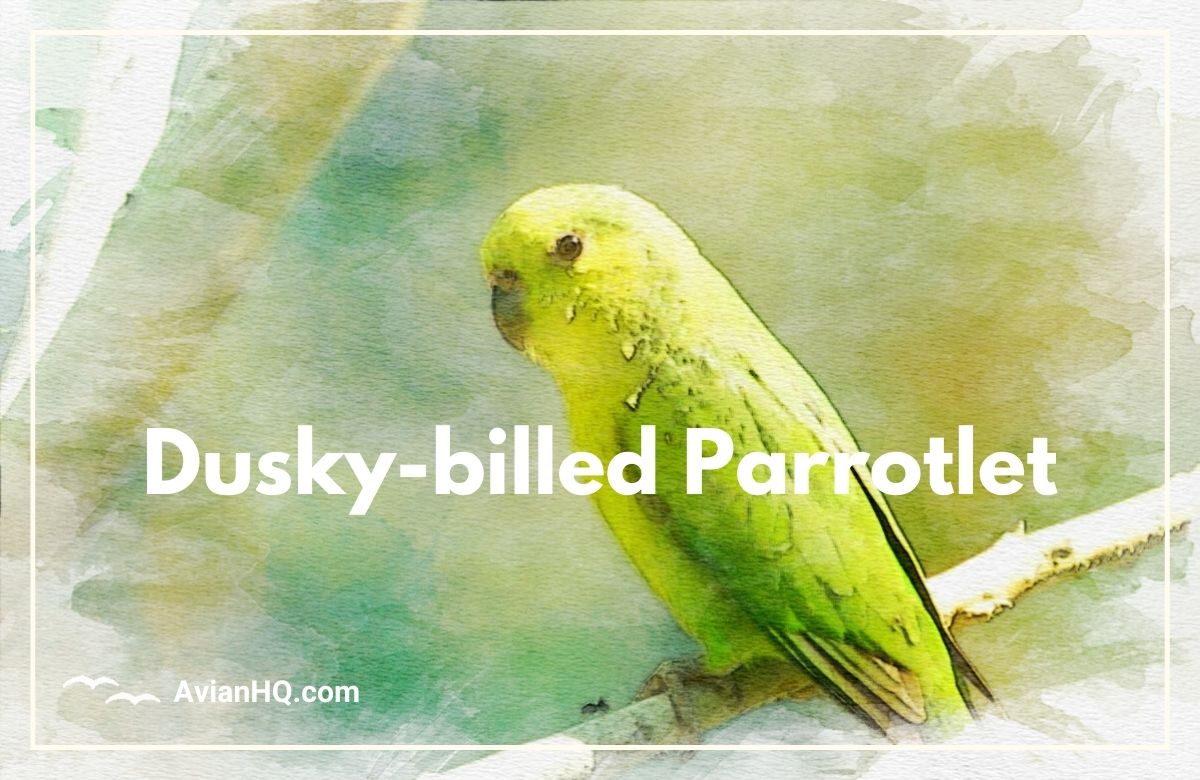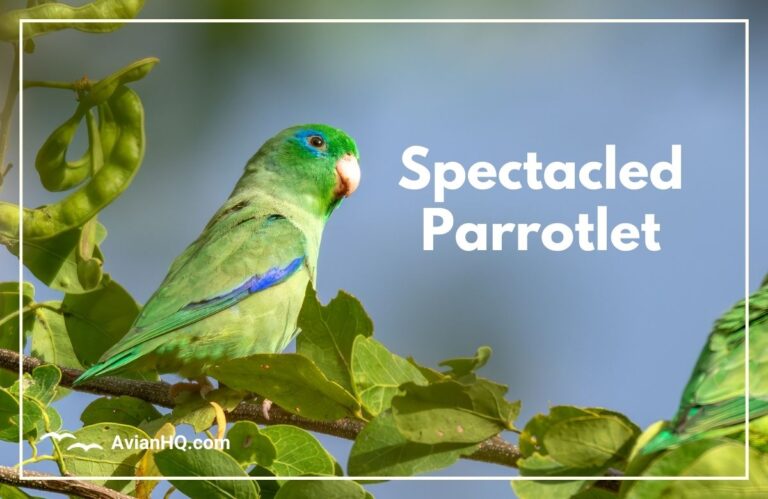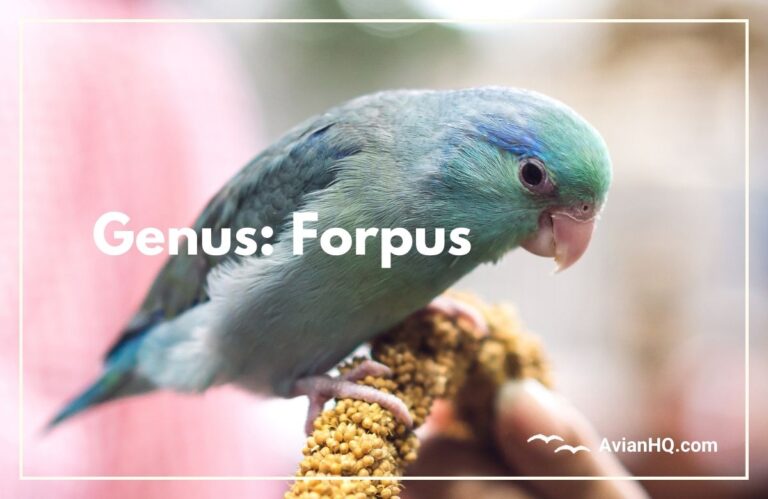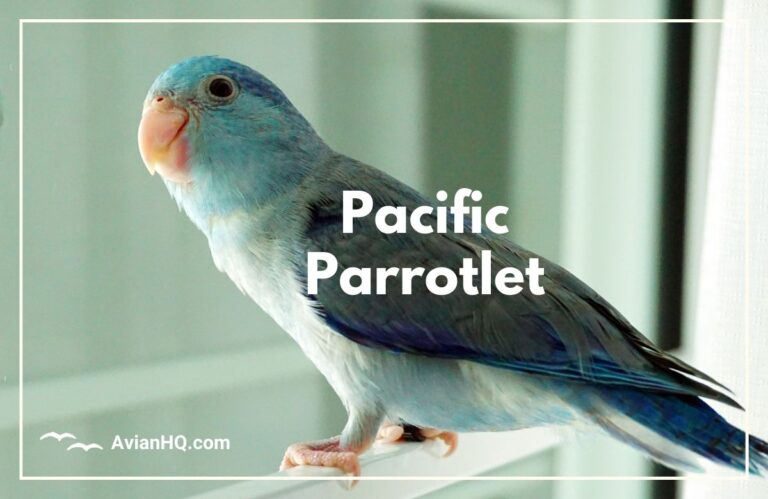Dusky-billed Parrotlet (Forpus modestus)
They may be one of the world’s smallest parrots, but Dusky-billed Parrotlets pack huge personality into their tiny frames. Weighing less than an ounce and small enough to fit in the palm of your hand, these vibrant green birds captivate bird lovers with their curious nature, lively chatter, and strong family bonds.
As you read on about these diminutive parrots, you’ll discover what makes Dusky-billed Parrotlets special. We’ll cover everything from their evolutionary history and identification tips, to fascinating behaviors around breeding, feeding, and socializing in the wild. You’ll also learn about conservation efforts to protect vulnerable populations of this species in parts of its native South American habitat.
So get ready to be charmed by the tiny Dusky-billed Parrotlet! While small, they have supersized charm and resilience thanks to some intriguing adaptations. Their bright green plumage helps them blend into forests and grasslands when danger is near. Plus, traveling in tight flocks gives them safety in numbers against predators. Read on to uncover more of these parrotlets’ secrets for survival despite their very small stature.
History and Taxonomy
The first documented sighting of the Dusky-billed Parrotlet was made in 1819 near the Brazilian city of Belém by German naturalists Johann Baptist von Spix and Carl Friedrich Philipp von Martius. However, it wasn’t officially named and described until 1856 by French ornithologist Charles Lucien Bonaparte.
Originally named Psittacula modesta due to its subtle plumage by Bonaparte, the Dusky-billed Parrotlet has gone through some taxonomic shuffling over the years before landing in its current classification:
Kingdom: Animalia
Phylum: Chordata
Class: Aves
Order: Psittaciformes
Family: Psittacidae
Genus: Forpus
Species: F. modestus
Within the genus Forpus, the Dusky-billed Parrotlet belongs to the passerinus species group, which also contains six other closely-related parrotlets including the Green-rumped Parrotlet. Its species name modestus translates from Latin as “modest” or “unassuming,” likely referencing its plain coloration compared to brighter members of the wider parrot family.
No recognized subspecies of the Dusky-billed Parrotlet currently exist. Studies of mitochondrial DNA and feather lice have uncovered a complex history of this species interacting and potentially hybridizing with Green-rumped Parrotlets where their ranges overlap along rivers like the Amazon. More research is needed to fully untangle the evolutionary tree.
Physical Appearance
The Dusky-billed Parrotlet is one of the smaller parrot species, measuring just 3.5-4 inches (9-10 cm) long and weighing roughly 0.6-0.9 ounces (18-25 grams). Its wingspan reaches about 6 inches (15 cm).
Plumage is primarily green on the back and wings, with a yellowish-green hue on the rump, belly, and flanks. The face and crown are olive-green, while the primary flight feathers on the wings are bluish-black. As the name suggests, the short conical bill is a dark grayish color.
Males and females look similar, though some report the male has slightly more vibrant plumage. Juveniles start out with less green overall, appearing dull gray with some green mottling that becomes more vibrant after their first molt around 4-6 months old.
Key physical features that aid survival include a short, square tail that assists with rapid direction changes in flight. Their petite but strong beaks help crack hard seeds and nuts. Large eyes give excellent vision to navigate dense forests and spot both food sources and predators.
Habitat and Distribution
The Dusky-billed Parrotlet occupies a wide range across northern and central South America east of the Andes Mountains. Its total global population is estimated between 100,000-500,000 individuals.
Their native habitat centers on landscapes that offer a mix of grasslands, savannas, and wetland forests, especially along riparian corridors. They seem to prefer drier regions rather than rainforests. Seasonally flooded plains, pastures, palm groves, and scrub provide ideal terrain.
Their range stretches across much of Brazil and into surrounding countries including Guyana, Suriname, French Guiana, Venezuela, Colombia, Ecuador, Peru, and Bolivia. Some vagrants have been spotted as far south as Paraguay and northern Argentina.
Regions densely populated by Dusky-billed Parrotlets include the savannas of Roraima state Brazil, the Beni lowlands of Bolivia, and palm-rich grasslands of the Llanos region shared by Colombia and Venezuela. Scattered populations in the Amazon Basin likely interact and interbreed with the closely related Green-rumped Parrotlet.
While still widespread across their native habitat, populations can fluctuate locally based on seasonal food supplies and rates of deforestation. No introduced or invasive populations have been reported to date.
Diet and Feeding
In the wild, Dusky-billed Parrotlets are primarily granivorous, feeding on a variety of grass, cereal, and crop seeds. Favored foods include millet, amaranth, buds and seeds of palms like acuri and bocaiuva, as well as fruit seeds.
They supplement this seed-based diet with some berries, fruits, flowers, and occasional insects when available. Their strong beaks allow them to crack hard nuts and seeds other small birds cannot handle.
Dusky-billed Parrotlets forage in small flocks called “molts”, often just 5-10 birds, but sometimes up to 30-50 birds when food is abundant. They typically feed peacefully alongside other seed-eating birds like seedeaters and finches. But they may compete with or be dominated by larger parakeet species.
In captivity, a balanced diet for pet Dusky-billed Parrotlets should include a quality seed mix of millets, oats, legumes, etc. This can be supplemented with vegetables, fruit, healthy table foods, nutritious pellets, and occasional treats. Cuttlebone provides beneficial calcium while grit aids digestion.
Breeding and Reproduction
Dusky-billed Parrotlets reach sexual maturity around 1-2 years of age, when they are just starting to gain their characteristic green plumage. The breeding season spans spring and summer (typically from September to February) across their South American range.
Once paired, courtship displays include preening, bill rubbing and regurgitation of food from males to females. Pairs defend a nest cavity aggressively, chasing away intruders with alarming squawks and physical attacks if needed.
Natural nest cavities may form in rotted palm stumps or bamboos walls, and can be up to 8 inches (20 cm) deep. The clutch size is typically 3-4 white eggs, which both parents incubate an average of 24-26 days. The altricial chicks fledge in about 40-45 days, depending heavily on both parents for feeding. Juveniles remain with the parents up to 3 months for further training.
While they may form lifelong bonds, pairs do not always stay constant across seasons. Females may pick new mates year-to-year, or accept a different male if the previous mate disappears. Research suggests a socially monogamous framework with some instances of “divorce” and rare cases of cooperative breeding when other adults help rear offspring.
Behavior and Ecology
Dusky-billed Parrotlets are highly social, spending most of their time in flocks ranging from just family groups up to 50+ birds during non-breeding seasons. Their daily rhythms revolve around periods of intensive foraging followed by social loafing and preening sessions to cement flock bonds.
Vocalizations play a key role in communication and coordination. Soft chip notes help maintain contact, while loud alarm calls alert others to predators like birds of prey. They are adept fliers that can fly long distances daily between roosting and feeding territories. They prefer to walk and climb using their beaks and feet more than flying when feeding and socializing if possible though.
Roosting overnight in dense vegetation provides protection. But if discovered, this species shows clever anti-predator behaviors. When mobbed by predators, flocks show synchronized flying maneuvers. And they may play dead, lying motionless with eyes closed and feet in the air. Parents are intensely protective if chicks are threatened.
Beyond breeding pairs, networks of cooperative associations exist between non-kin individuals. Allies watch for threats, mob together, and share food sources. These bonds seem to offer reciprocal benefits in enhancing safety, foraging success, and social connections.
Conservation Status
The Dusky-billed Parrotlet is currently classified as a species of Least Concern on the IUCN Red List of Threatened Species. Experts estimate their global population to be between 100,000 to 500,000 mature individuals with a stable overall population trend.
While still common and widespread in many regions, localized threats from habitat degradation have researchers keeping an eye on certain vulnerable populations. Deforestation to clear land for agriculture and grazing has led to some habitat fragmentation in parts of their range. Capture for the pet trade poses another minor to moderate threat in countries like Guyana, Suriname, and French Guiana.
Across their range, Dusky-billed Parrotlets inhabit several protected areas which offer refuge from human pressures. These include Manú National Park in Peru, Noel Kempff Mercado National Park in Bolivia, and multiple reserves in Brazil such as Carajás National Forest and Serra do Divisor National Park.
More broad-scale monitoring of population densities across various habitats will help determine future conservation priorities. But for now, responsible habitat management efforts combined with regulated pet trade practices should suffice to ensure species stability.
Cultural Significance
The small size and vibrant green plumage of Dusky-billed Parrotlets have made them popular as pets among indigenous communities and more recently the global exotic bird trade. Several Amazonian tribes are known to keep parrotlets as treasured companion animals.
Local folklore across their South American range connects parrotlets to concepts like freedom, vitality, and communication. The Tupi people of Brazil associated green parrots with rebirth and renewal each spring. And the trailblazing expedition notes of Spix and Martius praised parrotlets and macaws as welcome signs of civilization when spotted near villages along the Amazon River.
Beyond the Americas, Dusky-billed Parrotlets remain relatively unknown culturally. But fans across Europe and Asia are driving increasing international demand for the pet trade. Captive breeding struggles to keep up with growing desire to own these tiny green birds celebrated for their longevity, cleverness, and loyal bonds with caretakers when well-socialized.
While sustainable harvesting from wild populations warrants more oversight, responsibly managed captive breeding programs could satisfy much pet demand. This would allow Dusky-billed Parrotlets to continue charming people globally while also thriving undisturbed across their native habitat.
Conclusion
In the end, Dusky-billed Parrotlets prove you can’t judge a book by its cover – or in their case, judge a parrot’s personality by its small size! They encapsulate many of the best qualities people love about their larger, more colorful parrot cousins. Charming playfulness, impressive intelligence, doting parental care, and even longevity averaging 15-20 years shine through.
Beyond captivating pet owners, these tiny parrots play important ecological roles across South America’s savannas and wetland forests. As prolific seed dispersers and prey species interwoven in complex food chains, healthy Dusky-billed Parrotlet numbers contribute to broader habitat stability. Plus they serve as key bioindicators – species whose fates directly reflect environmental threats from land conversion to climate shifts.
Through responsible stewardship of remaining grasslands, palm groves, and floodplain oases these diminutive parrots rely on, humans can ensure Dusky-billed Parrotlet flocks continue dazzling future generations with their antics across many regions they enliven. Respectful harvesting coupled with captive breeding can also allow more homes worldwide to be graced by their petite yet powerful brand of parrot panache.






